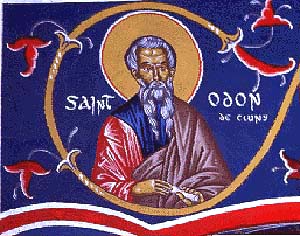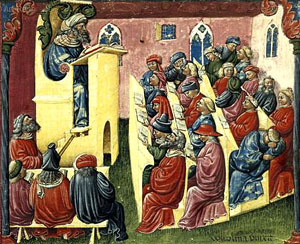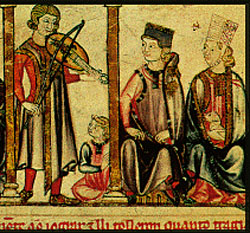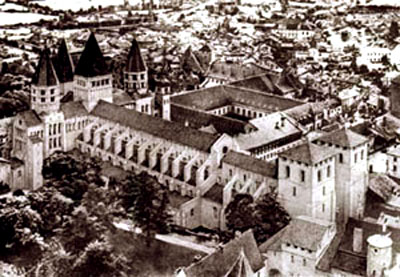 |
The Saint of the Day
St. Odo of Cluny – November 18
Prof. Plinio Corrêa de Oliveira
Biographical selection:
Odo (879-942) was son of noble parents who lived in the Alsace, France. They attributed his birth to the miraculous intercession of St. Martin of Tours. As a child he was sent to the court of Fulk the Good, Count of Anjou; later he went to the court of William, Duke of Aquitaine.

St. Odo of Cluny |
At age 16 he became a canon of the Church of St. Martin in Tours. He dedicated some years of his life to the study of classic authors and Fathers of the Church. In 901 he traveled to Paris to follow a course of philosophy by Remy of Auxerre. He also studied poetry and music, both of which he wrote and practiced throughout his life.
After writing several works, Odo entered the Benedictine Monastery of Baume-les-Messieurs in Burgundy, where he was headmaster of the monastery school. When the Monastery of Cluny was founded, he moved to it with its first abbot, St. Berno. In 927 he succeeded Berno as the second Abbot of Cluny.
The monastery schools he founded in Cluny shortly attracted the noblest and the brightest youth in the West. It became a custom to say that a prince at his parent’s court would not receive a better formation than the pupils of Cluny.
Thanks to this holy Abbot the influence of Cluny spread out all over Christendom. Popes would ask St. Odo’s advice in their difficulties, and Princes invited him to their kingdoms to reform their monasteries. He was so successful that he was called the “restorer of monasteries.” He died on November 18, 942.
Comments of Prof. Plinio:
Everything in this biography is interesting. It is curious to observe the names of the persons and the places where St. Odo received his formation.

A university class in the Middle Ages |
He was sent to the court of the Count of Anjou, Fulk the Good. At that time 'good' did not signify a charitable man, but rather a man who achieved the honorable things that he set out to do. It signified, therefore, the man who fulfilled his duties. This was Count Fulk: amiable and gentile with his friends and inferiors, but terrible against his enemies.
Then St. Odo went to the court of William of Aquitaine. Aquitaine was one of the greatest French feudal estates in the most poetic part of medieval France. We can imagine Duke William on his carved oak throne discussing with some of his subjects the affairs of his fief one late afternoon. Below the room, a stairwell opens to an large patio where knights and pages are training for battle.
The Angelus bell rings, and all stop what they are doing, stand, and pray in homage to Our Lady. Then, life continues. In an atmosphere like this St. Odo was raised. You see that it is quite different from that of the skyscrapers and busy streets to which many of us are accustomed.

A musician of those times |
St. Odo, who knew such interesting persons, then went to Paris to learn philosophy, poetry and music. You can imagine a student of that time, wearing his colorful habit and a hat with a long feather, meandering through the streets of Paris with his lute. He stops at the borders of the Seine, plays and sings a little, then continues on in the very poetic atmosphere of life at that time. It is as if we are seeing a figure in a stain glass window or an illuminated manuscript. Even if St. Odo were not one of those students, the description reflects well the university atmosphere he entered.
The fact that he simultaneously studied philosophy, music, and poetry reveals an expansive spirit, again very different from those of our days who study philosophy. Often they are stern, square-minded persons with a poor sense of reality. St. Odo cultivated both poetry and music his entire life. So, you can imagine how he would periodically set aside his hard work as Abbot of Cluny, and go to the chapel to play his musical instrument. He plays alone, his notes echoing through the arches of the chapel. He is a saint piously playing his musical instrument in that sacral place. We should not be surprised if at times an Angel would appear to accompany his music with celestial song.

Encounter of the Pope and members of his court, at left, with the Abbot of Cluny and his monks, at right |
Then he entered the Benedictine Order and went to the monastery of Beaume-les-Messieurs, a beautiful name; afterward he accompanied St. Berno to Cluny when this monastery was founded. After the death of St. Berno, he was chosen Abbot of Cluny.
We should consider that in many different ways the soul of the Middle Ages was Cluny. It was a great Benedictine Abbey that later had more than 1,000 abbeys spread over Europe dependant on it. It exerted an enormous influence and did an immense good. For example, Pope St. Gregory VII was a monk of Cluny, and this Pontiff in many senses was a living symbol of the Middle Ages.
So, after studying philosophy, poetry and music, after serving and governing in Beaume-les-Messieurs, St. Odo became one of the founders of Cluny. That is, we find him at the very root of the best that the Catholic Church gave in that era.
The schools he founded at Cluny attracted persons of the best families in Europe. Some progressivists hate this apostolate with children of good families. They argue that one must make apostolate with the poor, not with the elites of society. It is hard to imagine such blindness. If you want to do good for everyone, you should take special care to do so with those who, in their turn, can pass on that goodness to others.
Someone might object to a person who founded a school of medicine: “You should be taking care of the sick.” Such nonsense! If someone founds a school of medicine, he is taking the greatest care of the sick, because he is forming the physicians who will cure everyone. Analogously, when someone makes an apostolate with persons of good families, he is potentially doing a good for all society, over which they will naturally exert a great influence.

The immense Abbey of Cluny as it was in 1750,
before it was destroyed in the French Revolution |
We have the example of St. Odo. In an epoch when many people were illiterate, instead of opening schools for the simple people, the first thing St. Odo did was to open schools for the elites. Doing this he attracted noble youth from all over Europe and gave them the best formation possible. Hence he produced a movement with enormous dynamism that changed the face of Europe.
As almost always happened in the Middle Ages with saints like this, St. Odo was invited to be a counselor of Popes and Princes.
His life is worthy of being illustrated in stain glass windows. It gives us nostalgia for an era that we did not know, and raises in our souls a longing for the Reign of Mary that will be many times more splendid than the Middle Ages.
Let us ask St. Odo to intercede with Our Lady to bring the Reign of Mary soon for the greatest glory of God.


  | | Prof. Plinio Corrêa de Oliveira | |
The Saint of the Day features highlights from the lives of saints based on comments made by the late Prof. Plinio Corrêa de Oliveira. Following the example of St. John Bosco who used to make similar talks for the boys of his College, each evening it was Prof. Plinio’s custom to make a short commentary on the lives of the next day’s saint in a meeting for youth in order to encourage them in the practice of virtue and love for the Catholic Church. TIA thought that its readers could profit from these valuable commentaries.
The texts of both the biographical data and the comments come from personal notes taken by Atila S. Guimarães from 1964 to 1995. Given the fact that the source is a personal notebook, it is possible that at times the biographic notes transcribed here will not rigorously follow the original text read by Prof. Plinio. The commentaries have also been adapted and translated for TIA’s site.
|
Saint of the Day | Home | Books | CDs | Search | Contact Us | Donate

© 2002- Tradition in Action, Inc. All Rights Reserved
|
 |

|